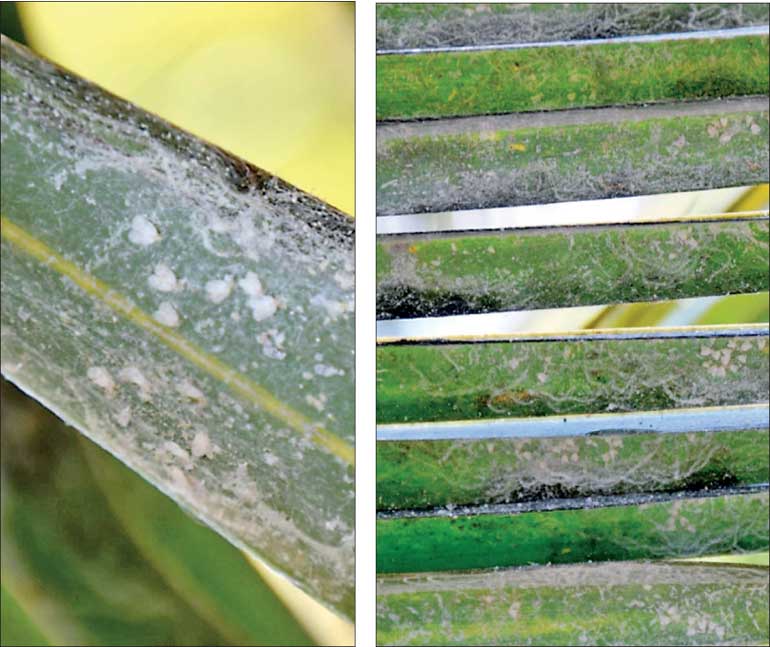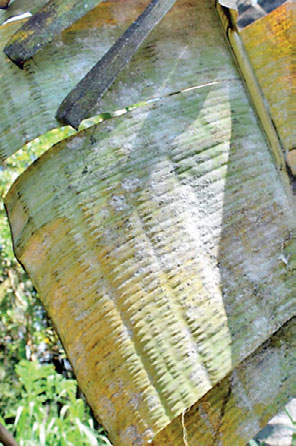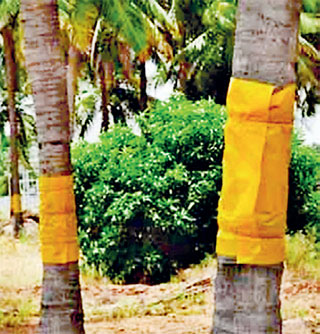Sunday Dec 14, 2025
Sunday Dec 14, 2025
Saturday, 24 December 2022 00:02 - - {{hitsCtrl.values.hits}}

A coconut leaf infested by White flies
Text and pix by P.D. De Silva
|
Coconut Research Institute Deputy Director Dr. Nayanie Aratchige |
 |
| Banana is a host plant |
 |
| Sticky yellow traps being used to control White Fly infestation
|
The White Fly species (Aleyrodidae) are becoming a growing threat to coconut and other agricultural crops in Sri Lanka.
White flies damage plants by sucking out plant juices. Heavily infested plants can be seriously weakened and grow poorly. Leaves often turn yellow, appear dry and drop prematurely. White flies also transmit crop viruses.
Coconut Research Institute Deputy Director (Research) Dr. Nayanie Aratchige says that around 1500 species of White Fly have been reported from around the world, of which four species, Aleurotrachelus atratus (Palm-infesting whitefly), Paraleyrodes minei (Citrus nesting whitefly), Aleurodicus disperses (Spiralling whitefly) and Aleurodicus cocois (Coconut whitefly) are presently a threat to coconut palms in Sri Lanka.
Dr. Aratchige said that the first mention of the White Fly plaguing coconut palms was in Barbados in 1846 and that outbreaks have been reported in the Caribbean and South American regions since the 1990s and outbreaks of Rugose spiralling whitefly (Aleurodicus rugioperculatus) in India since 2016.
The species Aleurodicus dispersus (Spiralling whitefly) has been present in Sri Lanka since 1990 but at that time it was considered a minor pest to coconut palms when compared to other crops.
The first major outbreak in coconut plantations in Sri Lanka was reported in 2019 from the Kegalle District and may have been caused by the accidental introduction of a new species via illegal importation of seedlings in the Palmae group, impact of climate change, sudden drop of natural enemy populations of the native population of White flies due to excessive use of insecticides on other crops.
Dr. Aratchige said that White flies have invaded coconut plantations in Gampaha, Kegalle, Kandy, Kalutara, Colombo, Kurunegala, Ratnapura, Puttalam and even the Galle, Matara and Hambantota Districts which have been battling the Weligama Coconut Leaf Wilt disease for over a decade.
Banana, Guava, Citrus, Avocado, Eggplant, Okra, Cashew, Indian almond (Kottamba), Caryota palm (Kithul palm), Areca nut, Ornamental plants, Curry leaves, Green Chilli, Mango, Jackfruit, Breadfruit, Neem, Pigeon pea, different varieties of Pepper, Water melon, Coffee etc., host the White Fly.
The Coconut Research Institute and the Coconut Cultivation Board are conducting awareness programs on identification of the pest and coordinated spraying of insecticides.
Dr. Aratchige said that placing yellow sticky traps or spraying of the following insecticides to control the menace is recommended.
Neem oil and soap mixture is recommended for all infested areas as this mixture is less toxic to the natural enemies of whiteflies. Artificial insecticides are particularly recommended for newly infested areas and the coconut seedling nurseries.
The CRI is researching methods of chemical and biological control and have sought assistance from other countries for importation of exotic natural enemies of the white fly.